
ENZYME
Enzyme
Like a catalyst, they increase the rate of biological reactions (106 to 1012 times faster). But, they are not changed at the end of the reaction.
They are made of proteins.
Lower the activation energy for the reaction.
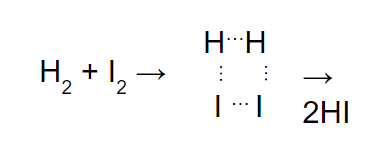
Less energy is required to convert reactants to products.
Most of enzymes are globular proteins (water soluble).
Proteins are not the only biological catalysts.
Most of enzymes are specific. (Trypsin: cleaves the peptide bonds of proteins)
Some enzymes are localized according to need. (digestive enzymes: stomach)
Names of Enzymes
By replacing the end of the name of reaction or reacting compound with the suffix « -ase ».
Oxidoreductases: oxidation-reduction reactions (oxidase-reductase).
Transferases: transfer a group between two compounds.
Hydrolases: hydrolysis reactions.
Lyases: add or remove groups involving a double bond without hydrolysis.
Isomerases: rearrange atoms in a molecule to form a isomer.
Ligases: form bonds between molecules.
Substrate: the compound or compounds whose reaction an enzyme catalyzes.
Active site: the specific portion of the enzyme to which a substrate binds during reaction.
Enzyme Catalyzed Reaction
An enzyme catalyzes a reaction by,
Attaching to a substrate at the active site (by side chain (R) attractions).
Forming an Enzyme-Substrate Complex (ES).
Forming and releasing products.
E + S ---- ES ---- E + P
Lock and Key Model
Enzyme has a rigid, nonflexible shape.
An enzyme binds only substrates that exactly fit the active site.
The enzyme is analogous to a lock.
The substrate is the key that fits into the lock
Induced Fit Model
Enzyme structure is flexible, not rigid.
Enzyme and substrate adjust the shape of the active site to bind substrate.
The range of substrate specificity increases.
A different substrate could not induce these structural changes and no catalysis would occur.
Factors affecting enzyme activity
Activity of enzyme: how fast an enzyme catalyzes the reaction.
Temperature
pH
Substrate concentration
enzyme concentration
Enzyme inhibition
Temperature
Enzymes are very sensitive to temperature.
At low T, enzyme shows little activity (not an enough amount of energy for the catalyzed reaction).
At very high T, enzyme is destroyed (tertiary structure is denatured).
Optimum temperature: 37°C or body temperature.
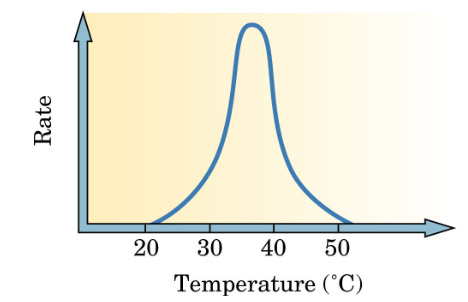
pH
Optimum pH: is 7.4 in our body.
Lower or higher pH can change the shape of enzyme. (active site change and substrate cannot fit in it)
But optimum pH in stomach is 2.
Stomach enzyme (Pepsin) needs an acidic pH to digest the food.
Some damages of enzyme are reversible.
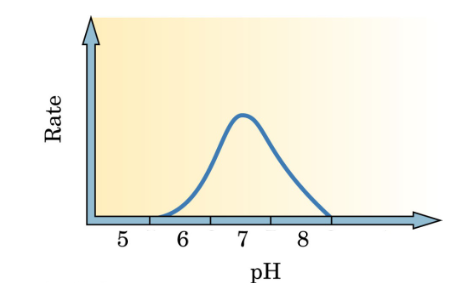
Substrate and enzyme concentration
Enzyme Concentration ^ - Rate of Reaction ^
Substrate Concentration ^ -
First: Rate of Reaction ^
End: Rate of reaction reaches to its maximum: all of the enzymes are combined with substrates.
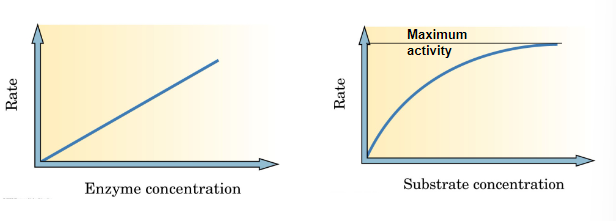
Enzymes inhibition
Inhibitors cause enzymes to lose catalytic activity.
Competitive inhibitor
Noncompetitive inhibitor
Competitive Inhibitor
Inhibitor has a structure that is so similar to the substrate.
It competes for the active site on the enzyme.
Solution: increasing the substrate concentration.
Noncompetitive Inhibitor
Inhibitor is not similar to the substrate.
It does not compete for the active site.
When it is bonded to enzyme, change the shape of enzyme (active site) and substrate cannot fit in the active site (change tertiary structure).
Like heavy metal ions (Pb2+, Ag+, or Hg2+) that bond with –COO-, or –OH groups of amino acid in an enzyme.
Penicillin inhibits an enzyme needed for formation of cell walls in bacteria: infection is stopped.
Solution: some chemical reagent can remove the inhibitors.
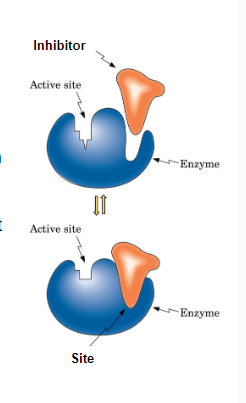
Competitive and Noncompetitive Inhibitor
Enzyme cofactors
Metal ions:
bond to side chains
obtain from foods.
Fe2+ and Cu2+ are gain or loss electrons in redox reactions.
Zn2+ stabilize amino acid side chain during reactions.
Enzyme and cofactors work together.
Catalyze reactions properly.
Vitamins and Coenzymes
Vitamins are organic molecules that must be obtained from the diet. (our body cannot make them)
Water-soluble vitamins: have a polar group (-OH, -COOH, or …)
They are not stored in the body (must be taken).
They can be easily destroyed by heat, oxygen, and ultraviolet light (need care).
Fat-soluble vitamins: have a nonpolar group (alkyl, aromatic, or …)
They are stored in the body (taking too much = toxic).
A, D, E, and K are not coenzymes, but they are important: vision, formation of bone, proper blood clotting.
Zymogens (Proenzymes)
Inactive enzyme that becomes an active
enzyme after a chemical change (remove or change some polypeptides).
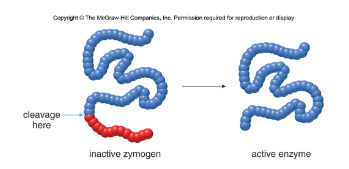
Trypsinogen (inactive enzyme – Pancreas) 🡪Trypsin (active enzyme – Small Intestine)
Digestive enzyme (hydrolyzes the peptide bonds of proteins)
Enzymes in medicine
Most of enzymes are in cells.
Small amounts of them are in body fluids (blood, urine,…).
Level of enzyme activity can be monitored.
Certain enzymes are present in higher amounts in particular cells.
If these cells are damaged or die, the enzymes are released into the bloodstream and can be detected.
Inhibitors can be useful drugs.
Penicillin inhibits the enzyme that forms cell walls of bacteria, destroying the bacterium.
ACE (angiotensin-converting enzyme) causes blood vessels to narrow, increasing blood pressure.
ACE inhibitors are given to those with high blood pressure to prevent ACE’s synthesis from its zymogen.
HIV protease is an essential enzyme that allows the virus to make copies of itself.
HIV protease inhibitors interfere with this copying, decreasing the virus population in the patient.
ENZYME
Enzyme
Like a catalyst, they increase the rate of biological reactions (106 to 1012 times faster). But, they are not changed at the end of the reaction.
They are made of proteins.
Lower the activation energy for the reaction.

Less energy is required to convert reactants to products.
Most of enzymes are globular proteins (water soluble).
Proteins are not the only biological catalysts.
Most of enzymes are specific. (Trypsin: cleaves the peptide bonds of proteins)
Some enzymes are localized according to need. (digestive enzymes: stomach)
Names of Enzymes
By replacing the end of the name of reaction or reacting compound with the suffix « -ase ».
Oxidoreductases: oxidation-reduction reactions (oxidase-reductase).
Transferases: transfer a group between two compounds.
Hydrolases: hydrolysis reactions.
Lyases: add or remove groups involving a double bond without hydrolysis.
Isomerases: rearrange atoms in a molecule to form a isomer.
Ligases: form bonds between molecules.
Substrate: the compound or compounds whose reaction an enzyme catalyzes.
Active site: the specific portion of the enzyme to which a substrate binds during reaction.
Enzyme Catalyzed Reaction
An enzyme catalyzes a reaction by,
Attaching to a substrate at the active site (by side chain (R) attractions).
Forming an Enzyme-Substrate Complex (ES).
Forming and releasing products.
E + S ---- ES ---- E + P
Lock and Key Model
Enzyme has a rigid, nonflexible shape.
An enzyme binds only substrates that exactly fit the active site.
The enzyme is analogous to a lock.
The substrate is the key that fits into the lock
Induced Fit Model
Enzyme structure is flexible, not rigid.
Enzyme and substrate adjust the shape of the active site to bind substrate.
The range of substrate specificity increases.
A different substrate could not induce these structural changes and no catalysis would occur.
Factors affecting enzyme activity
Activity of enzyme: how fast an enzyme catalyzes the reaction.
Temperature
pH
Substrate concentration
enzyme concentration
Enzyme inhibition
Temperature
Enzymes are very sensitive to temperature.
At low T, enzyme shows little activity (not an enough amount of energy for the catalyzed reaction).
At very high T, enzyme is destroyed (tertiary structure is denatured).
Optimum temperature: 37°C or body temperature.

pH
Optimum pH: is 7.4 in our body.
Lower or higher pH can change the shape of enzyme. (active site change and substrate cannot fit in it)
But optimum pH in stomach is 2.
Stomach enzyme (Pepsin) needs an acidic pH to digest the food.
Some damages of enzyme are reversible.

Substrate and enzyme concentration
Enzyme Concentration ^ - Rate of Reaction ^
Substrate Concentration ^ -
First: Rate of Reaction ^
End: Rate of reaction reaches to its maximum: all of the enzymes are combined with substrates.

Enzymes inhibition
Inhibitors cause enzymes to lose catalytic activity.
Competitive inhibitor
Noncompetitive inhibitor
Competitive Inhibitor
Inhibitor has a structure that is so similar to the substrate.
It competes for the active site on the enzyme.
Solution: increasing the substrate concentration.
Noncompetitive Inhibitor
Inhibitor is not similar to the substrate.
It does not compete for the active site.
When it is bonded to enzyme, change the shape of enzyme (active site) and substrate cannot fit in the active site (change tertiary structure).
Like heavy metal ions (Pb2+, Ag+, or Hg2+) that bond with –COO-, or –OH groups of amino acid in an enzyme.
Penicillin inhibits an enzyme needed for formation of cell walls in bacteria: infection is stopped.
Solution: some chemical reagent can remove the inhibitors.

Competitive and Noncompetitive Inhibitor
Enzyme cofactors
Metal ions:
bond to side chains
obtain from foods.
Fe2+ and Cu2+ are gain or loss electrons in redox reactions.
Zn2+ stabilize amino acid side chain during reactions.
Enzyme and cofactors work together.
Catalyze reactions properly.
Vitamins and Coenzymes
Vitamins are organic molecules that must be obtained from the diet. (our body cannot make them)
Water-soluble vitamins: have a polar group (-OH, -COOH, or …)
They are not stored in the body (must be taken).
They can be easily destroyed by heat, oxygen, and ultraviolet light (need care).
Fat-soluble vitamins: have a nonpolar group (alkyl, aromatic, or …)
They are stored in the body (taking too much = toxic).
A, D, E, and K are not coenzymes, but they are important: vision, formation of bone, proper blood clotting.
Zymogens (Proenzymes)
Inactive enzyme that becomes an active
enzyme after a chemical change (remove or change some polypeptides).

Trypsinogen (inactive enzyme – Pancreas) 🡪Trypsin (active enzyme – Small Intestine)
Digestive enzyme (hydrolyzes the peptide bonds of proteins)
Enzymes in medicine
Most of enzymes are in cells.
Small amounts of them are in body fluids (blood, urine,…).
Level of enzyme activity can be monitored.
Certain enzymes are present in higher amounts in particular cells.
If these cells are damaged or die, the enzymes are released into the bloodstream and can be detected.
Inhibitors can be useful drugs.
Penicillin inhibits the enzyme that forms cell walls of bacteria, destroying the bacterium.
ACE (angiotensin-converting enzyme) causes blood vessels to narrow, increasing blood pressure.
ACE inhibitors are given to those with high blood pressure to prevent ACE’s synthesis from its zymogen.
HIV protease is an essential enzyme that allows the virus to make copies of itself.
HIV protease inhibitors interfere with this copying, decreasing the virus population in the patient.
 Knowt
Knowt